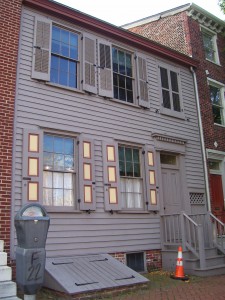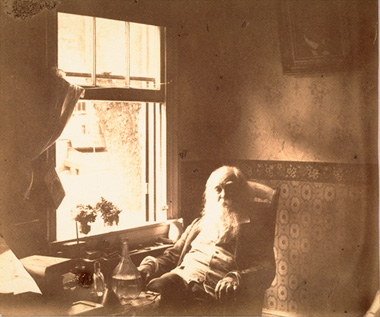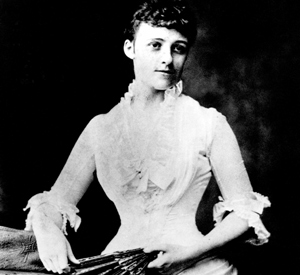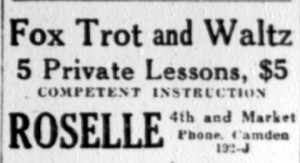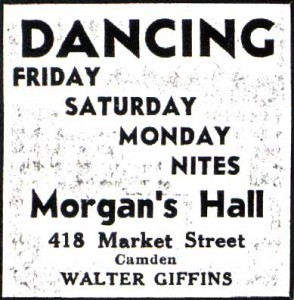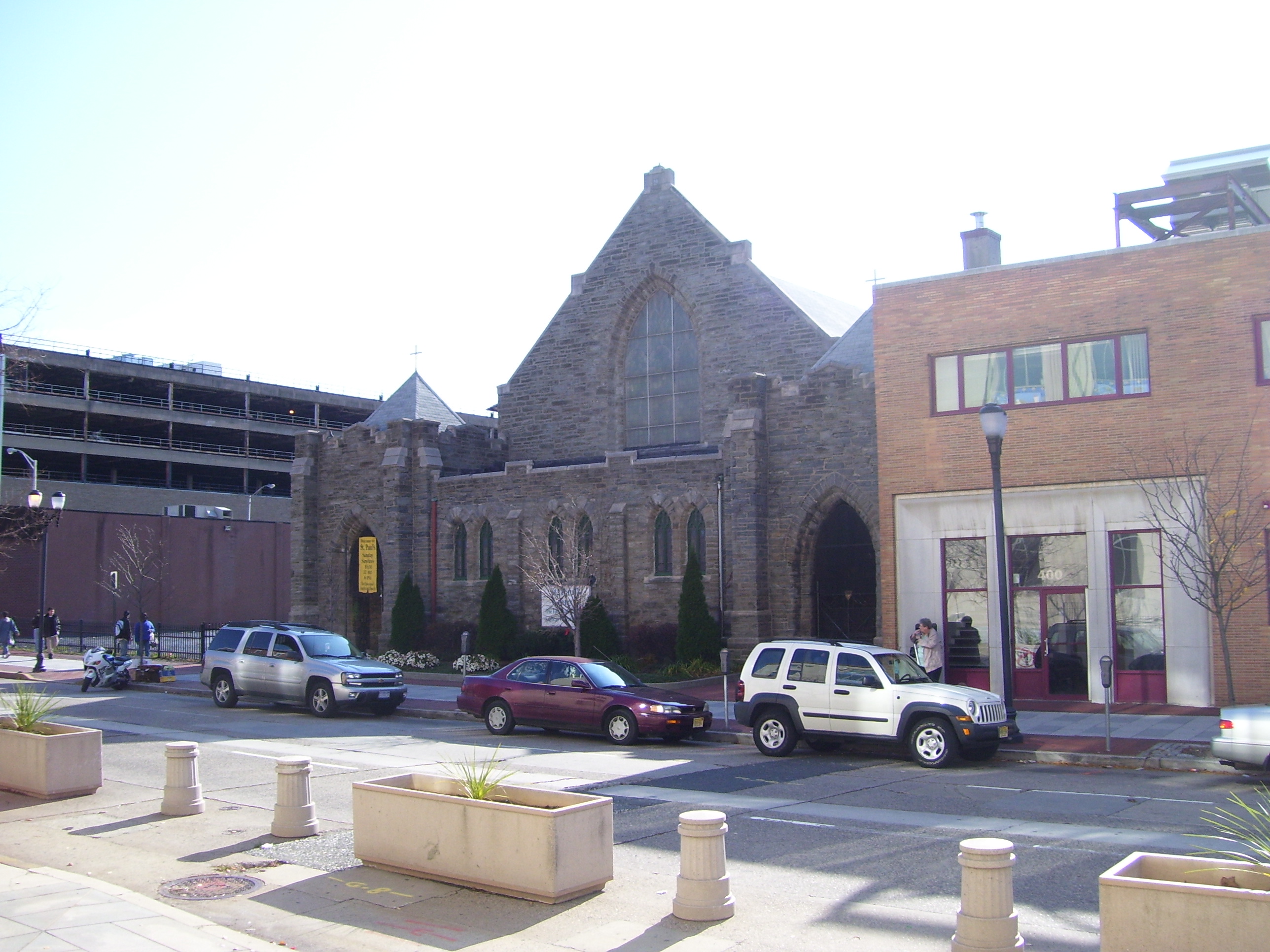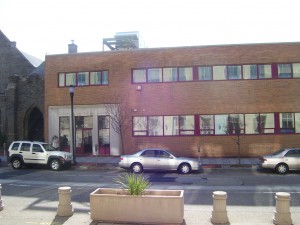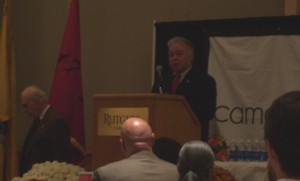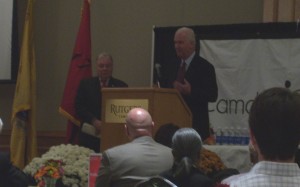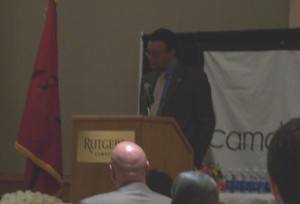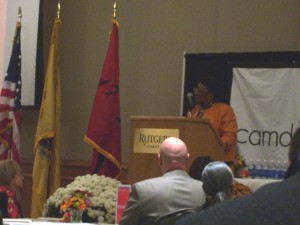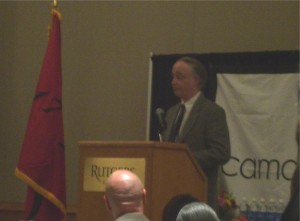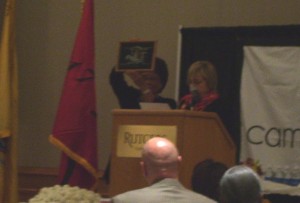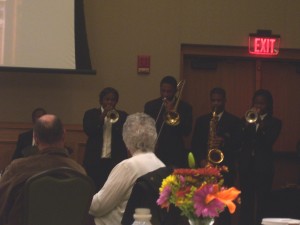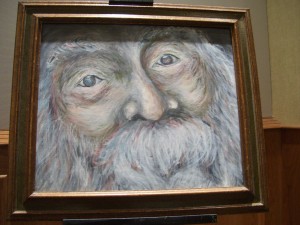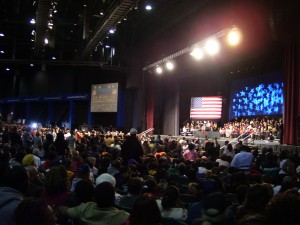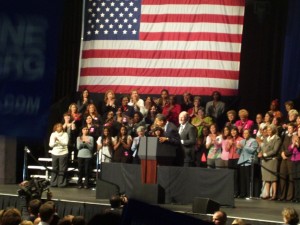The following link is to my final project prospectus. I plan to analyze a selection of the poems Whitman wrote during his years in Camden through the lens of ecocriticism. It seems as though Whitman, like many of his contemporaries, eagerly anticipated the booming industry of late nineteenth-century America, but also recognized the potential environmental destruction that came as a result.
Tags: finalproject
Recently I’ve been reading Walt Whitman in Mickle Street, a short book published by Elizabeth Leavitt Keller in 1921. Keller wrote this account Whitman’s life in Camden after serving as a nurse to him just before he died. Keller’s observations and chronicling of the happenings at 328 Mickle Street make one feel as if she were some kind of documentary director in the making. In her Preface, she claims to have written the book after being asked many times to discuss the particulars of Walt’s final days with the press and his friends. An interesting aspect of the book, however, is her focus on the role of Mary Davis, who, according to Keller, lived a life “of self-sacrifice and devotion to others” (2). Mary Davis, whose name is also the title of the book’s first chapter, is painted by Keller as constantly giving and nurturing, despite Walt’s particular preferences about household matters and the “messiness” of his surroundings. None of this is all that surprising; we know that Walt kept piles of paper around his room, refused to let Mary empty the trash can, and, due to illness, had no role in the general upkeep of the house. A somewhat new aspect of Mary’s portrayal, though, is her role as (what we’d call today) a personal assistant.
According to Keller, when Whitman’s illness “anchored” him at home in 1888, the number of visitors to the small Camden row house increased greatly. People were eager to see Walt and, because he could not come to them, they made their best attempts to visit him. Unfortunately, many of these visitors were unaware of the poet’s private health problems and his disinterest in constantly entertaining guests. When people would arrive unannounced to see Walt, Mary’s role became that of a secretary “screening calls” as it were. Keller writes:
Strange that these were often the days when visitors would flock there, the great majority of whom would leave deeply disappointed, and for this cause the inoffensive housekeeper—she who had to bear the brunt of everything—incurred the displeasure, even the enmity, of some people. …She invariably met each individual pleasantly and never spoke hastily or abruptly to anyone; she always gave civil answers to their questions; often went to Mr. Whitman to intercede for them; and it was through her influence along that many were admitted to his presence. But if he was not disposed to yield, her best efforts would be in vain, and the only alternative left her was to offend others instead of him. (116-117)
Essentially, Mary became a sort of public relations manager for Walt. She was often responsible for the way others perceived him and would do her best to make both Walt and his visitors happy. When Walt refused to see visitors, however, it was Mary who was left to endure their complaints, frustration, and disappointment. If Walt and Mary were at 328 Mickle Street in the late twentieth century, I think Mary would be running around the house with a cell phone in one hand and a pager in the other. The vacuum would probably be running, much to Walt’s anxiety about losing any important piece of paper, and there would likely be some kind of intercom system installed to prevent the constant running up and down the stairs to inform Walt of his guests’ arrival. In reading about Mary’s life with Walt in Camden, I cannot help but see them as a sort of business team. It seems as if her role was more akin to a modern celebrity’s personal assistant than to today’s housekeeper.
While doing a little Whitman “googling” earlier today, I came across a 2005 article from the New York Times by Charles McGrath. Aptly titled “O Camden! My Camden!”, McGrath reflects on the state of Camden (as well as the other Whitman locales). Before embarking on a bit of a chronology of Whitman’s different “homes” and locations, McGrath provides his prediction of what a modern revision of “Song of Myself” could possibly include. He suggests:
You black-topp’d highways! You white-strip’d lanes for passing, cruising and breaking down!
You teeming toll plazas! You capacious token baskets! You springy barriers that leap up for E-ZPass!
You welcoming rest stops! You lead-free pumps! You food courts featuring Roy Rogers, Carvel and Mickey D’s! You Sunglass Huts!
I salute you all! And I embrace my fellow travelers, each and every one, as I ride side by side with you in your Denali, and you with me in my Silverado pickup!
While these revisions don’t exactly strike me as particularly Whitman-esque, McGrath uses them to motivate a discussion of how some of today’s historical Whitman sites are acknowledged by tourists and visitors. According to his research, the Whitman homestead in Huntington, NY remains a very popular site for visitors. In addition to a visitor center, the house itself embodies the historical “feel” of authentic nineteenth-century life, complete with chamber pots and a lack of electrical outlets. McGrath calls the Huntington site a “regular fixture on the school field-trip circuit.”
McGrath contrasts the popularity of the original Whitman home with that of his final abode here in Camden. Although 328 Mickle Street attracted the likes of Oscar Wilde and Bram Stoker when Whitman resided there, today it boasts a rather lackluster visitor rate. The Walt Whitman House has far fewer visitors than the home in Huntington, but, as McGrath points out, its “feel” is a great deal more literary. Personally, I’m struck by the authenticity of seeing piles of paper on Whitman’s bedroom floor and the window by which he sat for that famous portrait by Thomas Eakins. Despite its not quite being a “regular fixture” for field-trips (as McGrath classifies the Huntington house), it seems to embody much more of the Whitman spirit we’ve come to know and appreciate in Whitman’s work.
There are likely many factors contributing to the difference in popularity between Huntington and Camden. After attending the Walt Whitman House Dedication Ceremony last week, I’m hoping that the new label of “literary landmark” might help attract this kind of recognition. It seems that even though Whitman’s legacy is so well-known and reputable today, the little row house in Camden remains a bit of a “hidden jewel” so-to-speak.
Tags: camden, walt whitman house, ww20
A more tangible version of my bibliographic essay, which examines Whitman’s role as a citizen poet of New York, is available in PowerPoint form by clicking here.
Morgan’s Hall was located at the corner of Fourth and Market Streets in Camden. Construction on Morgan’s Hall was completed on October 5, 1848. Originally named Odd Fellows Hall at a dedication ceremony on November 8, 1849, the three-story building was designed to host local lodges. After a lack of interest, Odd Fellows Hall was sold to John Morgan in 1851 for $6,000. Morgan, who appropriately enough renamed the building after himself, remodeled it and added space for private residences. By 1867, the building had undergone these changes and also had a new stucco outer covering.
The hall was “considered the fanciest public meeting place in Camden,” that is, until the opening of the Temple Theater across the street in 1892 (“Morgan’s Hall”). In the mid-1930’s, Walter and Ernestine Griffins began managing the building. Ernestine is believed to have opened The Owl’s Studio (a dance instruction facility) around 1933. During the 1930s, the Griffins promoted many dances in Morgan’s Hall. Throughout the 1930s and 40s, Morgan’s Hall hosted many weddings, contests, and other public and private events.
Morgan’s Hall was located right next to St. Paul’s Episcopal Church, which remains in service today. The latest records of activity at Morgan’s Hall date back to 1947. According to the New Jersey Bell Telephone Directory, no listing for Morgan’s Hall exists after 1959.
Although there’s little evidence that Whitman spent much time at Morgan’s Hall, it was the site of his often written-about seventieth birthday celebration. On May 31, 1889, a large crowd gathered to salute Whitman and partake in revelry that included an array of fine foods, desserts, and cigars—not to mention the company of a diverse crowd of writers, lawyers, and businessmen.
Many credit Whitman’s residence in Camden for having brought many notable writers and artists through the city. According to biographer David S. Reynolds, Whitman’s visitors included Oscar Wilde, Edmund Gosse, and Henry Wadsworth Longfellow (3). Reynolds opens his Walt Whitman’s America: A Cultural Biography with a detailed account of the celebration. He describes not only the attendees, mood, and atmosphere of the day, but also provides us with some images of the inside of the hall:
The heavy skies that day threatened rain, but the atmosphere inside Morgan’s was festive. Three long rows of dinner tables, two of them parallel with the third crossing them at the top, were the picture of elegance, with dazzling whit tablecloths and flowers everywhere. Banners festooned the walls, and a band played from a platform. (3)
Although the hall was beautifully decorated and the party enthusiastically attended, Whitman had, by this point, begun to tire of such public celebrations. In fact, he intended to only stay at the party for a few minutes, but ended up spending two to three hours there. During the festivities, an ailing Whitman sipped champagne and listened to the greetings and toasts of those in attendance and those who had sent remarks. According to Reynolds, “When he left Morgan’s Hall that stormy May evening he took with him a rose and a memory of a grand occasion.” (6). Although the setting of this grand occasion is not longer in business here in Camden, this major literary event drew a great deal of attention to the city. Like the Walt Whitman House and Harleigh Cemetery today, Morgan’s Hall, in its heyday, drew residents and out-of-staters alike to its offerings of a glimpse into Whitman’s literary career.
Today, the building next to St. Paul’s is considered 400 Market Street. The unmarked building houses several small business and medical offices.
Works Cited
Reynolds, David S. Walt Whitman’s America: A Cultural Biography. New York: Vintage Books, 1995. Print.
“Morgan’s Hall.” Delaware Valley Rhythm and Blues Society. Web. 7 November 2009.
Tags: birthday, camden, digitalmuseum, morganshall, ww20
The Walt Whitman house was celebrated today at a ceremony honoring it as a Literary Landmark. The ceremony was held in the Campus Center at Rutgers Camden. It was a true celebration of Whitman’s legacy.
Below are some photos of the event.
Mr. Roberts was responsible for securing the $2 million investment in restoring and expanding the Walt Whitman house in Camden. He called Whitman “someone who has been underappreciated in his own backyard” and said that this dedication “is long overdue.”
Dr. Pritchett remarked that Whitman’s values overlap with the values of Rutgers scholars: “scholarship, teaching, and civic engagement.”
Mayor Faison called it “an exceptional day to do something really really good.”
Dr. Gillette presented an essay on Whitman and Camden, stating that “no figure can be more appropriate to a city under siege.” He discussed Whitman’s arrival in Camden and his death and funeral procession. Dr. Gillette mentioned how people assumed Camden would become “America’s Stratford” and that Whitman’s pressence made it “gorgeous.” Although this hasn’t exactly turned out to be the case, he explained that the house “is central to facing Camden’s adversity.”
Renee Becker Swartz is the Chair and Coordinator for the New Jersey Center for the Book, the organization responsible for the dedication. She proclaimed that this event places Camden on the map as a “major destination on the literary highway.” She also discussed Whitman in terms of his connection to the America people, stating that “his was a celebration of the eloquence of the common man,…his became the voice of the American people.”
The Creative Arts High School students performed at the end of the ceremony. Other students from local schools were celebrated for their artwork and poetry.
I’m really interested in exploring how Whitman defined his role as a poet, particularly the metaphor of the poet as a soldier. For this assignment, I worked with a role for which more scholarship exists.
This bibliographic essay discusses recent criticism (since 1993) about Whitman’s role as a poet of the city, focusing on his time in New York.
As a recent New Jersey transplant, I know little about the political environment in which I live. It didn’t take long, however, for me to find out that a major race for Governor was approaching, what with the ads flashing on the television about every ten minutes. As New Jerseans prepared to fill out their ballots, rumors spread about a rally on Sunday for incumbent John Corzine. Even more curious, President Obama would be making an appearance. And the most interesting part about this rally? It was set to take place right here in Camden.
Some friends and I did a little investigating and secured tickets to attend. The rally was held at the Susquehanna Bank Center, which is just along the waterfront and a short walk from the Whitman house. The section of the city surrounding Rutgers was closed down that day for another major event: the Run the Bridge challenge. 4,000 participants raised money and ran to support children with special needs who attend the Larc School. As we walked along the waterfront to reserve our spot in line on a chilly, drizzly morning, we were surrounded not only by those who were also going to the rally, but also by the runners, their families, and the event coordinators. In fact, from the spot we stood for about an hour, we had an incredible view of the last half mile of the race. Two major events were taking place in Camden and literally intersecting with one another.
As we waited in line and eventually made our way inside, we met a lot of Camden residents who were very excited about seeing both John Corzine and President Obama speak. Shortly after arriving, a band began playing and people in the crowd were energized. The place was packed and people were ready to meet their politicians.
I spent most of the two hours of waiting for the speakers to arrive reading my literary theory chapters for the week. And, as I’m always trying to connect the theory back to Whitman’s work, I couldn’t help but consider how much of Whitman’s spirit must have been in and around the rally. The many people who surrounded us represented all classes, ages, genders, ethnicities. It was like looking at a visual of one of Whitman’s catalogs of city dwellers. Not only that, but the very feeling of people being so immersed in and passionate about the political system and what they firmly believe can be done to make their community better, felt rather Whitmanesque. It was amazing to see the people of Camden County unified, together as a front, trying to make something happen. Unity isn’t exactly something that I feel walking up and down the streets of Camden everyday.
When President Obama came out on stage, the crowd exploded into roaring cheers and shouts. I had never attended a political rally, never mind one in which the President is in attendance, but it felt like a pretty surreal experience. Obama was speaking not just about John Corzine and the state of NJ, but about the particular plight of cities like Camden. His solution, like Whitman’s, was that citizens need to come together. Of course, in this case, coming together meant voting for John Corzine and endorsing the Democratic nominee.
Although Corzine did not win yesterday’s election, I still believe that both he and President Obama provided all those in attendance at Sunday’s rally with a really strong message. They weren’t simply there to get people to vote, but they were there to get people to make change. The sentiments of unity and cohesiveness ring so true back in Whitman’s poetry, that I couldn’t help but think Whitman would be happy to see such great messages and positive community-building happening right here in Camden.
This week we made our way across Camden to Harleigh Cemetery, the site of Whitman’s mausoleum. As we drove through Camden (and got a little mixed up along the way), we were surrounded by what we have come to know as being very typical of this city. Let’s just say it’s far from the bustling Brooklyn-esque environment Whitman once called home.
Turning into Harleigh, however, is like turning into a completely different place and time. The cemetery is spacious and clean, natural and seemingly untainted by the city that surrounds it. Made all the more beautiful by the falling leaves and perfect autumn temperatures, the view from Whitman’s resting place is nothing but ideal.
I had seen pictures of the tomb in books before arriving there on Wednesday, so the appearance of Whitman’s grand design was not surprising. Against the background of gray stone and dead brown leaves, though, was a quaint little pumpkin, resting comfortably against the memorial that features Whitman’s image.
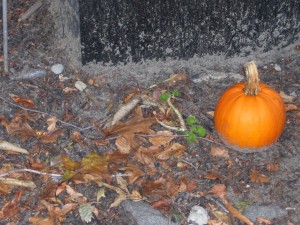
The pumpkin, not the monument, was actually the first thing that I noticed as we approached. It probably stood out simply because of its color, but the pumpkin, I think, speaks volumes about Whitman’s effect on the average American today. Although he rests here in the heart of a city that, many would argue, is far from his image of a unified America, someone decided Whitman might like a little pumpkin for the fall. It’s not large and gaudy, just a little color and charm.
The little pumpkin is an acknowledgement of Whitman’s relevance today in Camden and in America. It, as well as the flowers left at the gate, are symbols of our attempts to give back to the old bard who gave America so much. Some of us give by dedicating hours to scholarly work or academic blogs; others buy pumpkins. Even in death, Whitman’s goal of appealing to the American masses seems not only fulfilled, but ongoing.
